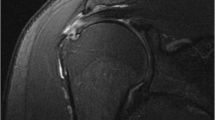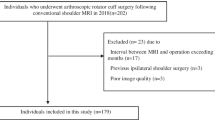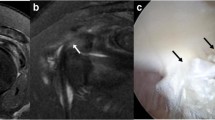Abstract
Objectives
To compare the accuracy of indirect magnetic resonance arthrography and noncontrast magnetic resonance imaging for diagnosing rotator cuff tears.
Materials and methods
In total, 333 patients who underwent noncontrast magnetic resonance imaging or indirect magnetic resonance arthrography were included retrospectively. Two musculoskeletal radiologists evaluated the images for the presence of supraspinatus-infraspinatus and subscapularis tendon tears. The overall diagnostic performance was calculated using the arthroscopic findings as the reference standard. Statistical differences between the diagnostic performances of the two methods were analyzed.
Results
Ninety-six and 237 patients who underwent noncontrast magnetic resonance imaging and indirect magnetic resonance arthrography were assigned into groups A and B, respectively. Sensitivity for diagnosing articular-surface partial-thickness supraspinatus-infraspinatus tendon tear was slightly higher in group B than in group A. Statistical significance was confirmed by multivariate analysis using the generalized estimating equation (p = 0.046). The specificity for diagnosing subscapularis tendon tear (85 % vs. 68 %, p = 0.012) and grading accuracy (57 % vs. 40 %, p = 0.005) was higher in group B than in group A; the differences were statistically significant for one out of two readers. Univariate analysis using the generalized estimating equation showed that the accuracy for diagnosing subscapularis tendon tear in group B was higher than in group A (p = 0.042). There were no statistically significant differences between the diagnostic performances of both methods for any other parameters.
Conclusion
Indirect magnetic resonance arthrography may facilitate more accurate diagnosis and grading of subscapularis tendon tears compared with noncontrast magnetic resonance imaging.





Similar content being viewed by others

References
Winalski CS, Aliabadi P, Wright RJ, Shortkroff S, Sledge CB, Weissman BN. Enhancement of joint fluid with intravenously administered gadopentetate dimeglumine: technique, rationale, and implications. Radiology. 1993;187(1):179–85.
Drape JL, Thelen P, Gay-Depassier P, Silbermann O, Benacerraf R. Intraarticular diffusion of Gd-DOTA after intravenous injection in the knee: MR imaging evaluation. Radiology. 1993;188(1):227–34.
Vahlensieck M, Sommer T, Textor J, et al. Indirect MR arthrography: techniques and applications. Eur Radiol. 1998;8(2):232–5.
Yagci B, Manisali M, Yilmaz E, et al. Indirect MR arthrography of the shoulder in detection of rotator cuff ruptures. Eur Radiol. 2001;11(2):258–62.
Bergin D, Schweitzer ME. Indirect magnetic resonance arthrography. Skelet Radiol. 2003;32(10):551–8.
Dinauer PA, Flemming DJ, Murphy KP, Doukas WC. Diagnosis of superior labral lesions: comparison of noncontrast MRI with indirect MR arthrography in unexercised shoulders. Skelet Radiol. 2007;36(3):195–202.
Lee MJ, Motamedi K, Chow K, Seeger LL. Gradient-recalled echo sequences in direct shoulder MR arthrography for evaluating the labrum. Skelet Radiol. 2008;37(1):19–25.
Vahlensieck M, Peterfy CG, Wischer T, et al. Indirect MR arthrography: optimization and clinical applications. Radiology. 1996;200(1):249–54.
Jung JY, Yoon YC, Yi SK, Yoo J, Choe BK. Comparison study of indirect MR arthrography and direct MR arthrography of the shoulder. Skelet Radiol. 2009;38(7):659–67.
Sommer T, Vahlensieck M, Wallny T, et al. Indirect MR arthrography in the diagnosis of lesions of the labrum glenoidale. Röfo. 1997;167(1):46–51.
Wagner SC, Schweitzer ME, Morrison WB, Fenlin Jr JM, Bartolozzi AR. Shoulder instability: accuracy of MR imaging performed after surgery in depicting recurrent injury—initial findings. Radiology. 2002;222(1):196–203.
Van Dyck P, Gielen JL, Veryser J, et al. Tears of the supraspinatus tendon: assessment with indirect magnetic resonance arthrography in 67 patients with arthroscopic correlation. Acta Radiol. 2009;50(9):1057–63.
Lee JH, Yoon YC, Jee S. Diagnostic performance of indirect MR arthrography for the diagnosis of rotator cuff tears at 3.0 T. Acta Radiol. 2015;56(6):720–6.
Herold T, Bachthaler M, Hamer OW, et al. Indirect MR arthrography of the shoulder: use of abduction and external rotation to detect full- and partial-thickness tears of the supraspinatus tendon. Radiology. 2006;240(1):152–60.
Allmann K-H, SCHÄFER O, Hauer M, et al. Indirect MR arthrography of the unexercised glenohumeral joint in patients with rotator cuff tears. Investig Radiol. 1999;34(6):435.
Clark J, Harryman D. Tendons, ligaments, and capsule of the rotator cuff. J Bone Joint Surg Am. 1992;74(5):713–25.
Minagawa H, Itoi E, Konno N, et al. Humeral attachment of the supraspinatus and infraspinatus tendons: an anatomic study. Arthrosc: J Arthrosc Relat Surg. 1998;14(3):302–6.
Mochizuki T, Sugaya H, Uomizu M, et al. Humeral insertion of the supraspinatus and infraspinatus: new anatomical findings regarding the footprint of the rotator cuff. J Bone Joint Surg Am. 2008;90(5):962–9.
Yoo JC, Rhee YG, Shin SJ, et al. Subscapularis tendon tear classification based on 3-dimensional anatomic footprint: a cadaveric and prospective clinical observational study. Arthroscopy. 2015;31(1):19–28.
Opsha O, Malik A, Baltazar R, et al. MRI of the rotator cuff and internal derangement. Eur J Radiol. 2008;68(1):36–56.
Kassarjian A, Bencardino JT, Palmer WE. MR imaging of the rotator cuff. Radiol Clin N Am. 2006;44(4):503–23. vii-viii.
Razzano A, Morscher M, Jones K, Eghbal A. Indirect shoulder MR arthrography: a novel technique for identifying labral pathology in young patients. Orlando, FL: American Academy of Pediatrics National Conference and Exhibition; 2013. p. 26–9.
Fallahi F, Green N, Gadde S, Jeavons L, Armstrong P, Jonker L. Indirect magnetic resonance arthrography of the shoulder: a reliable diagnostic tool for investigation of suspected labral pathology. Skelet Radiol. 2013;42(9):1225–33.
Oh DK, Yoon YC, Kwon JW, et al. Comparison of indirect isotropic MR arthrography and conventional MR arthrography of labral lesions and rotator cuff tears: a prospective study. AJR Am J Roentgenol. 2009;192(2):473–9.
Vahlensieck M, Sommer T. Indirect MR arthrography of the shoulder. An alternative to direct MR arthrography? Radiologe. 1996;36(12):960–5.
Song KD, Kwon JW, Yoon YC, Choi SH. Indirect MR arthrographic findings of adhesive capsulitis. AJR Am J Roentgenol. 2011;197(6):W1105–9.
Pfirrmann CW, Zanetti M, Weishaupt D, Gerber C, Hodler J. Subscapularis tendon tears: detection and grading at MR arthrography. Radiology. 1999;213(3):709–14.
Lo IK, Burkhart SS. The etiology and assessment of subscapularis tendon tears: a case for subcoracoid impingement, the roller-wringer effect, and TUFF lesions of the subscapularis. Arthroscopy. 2003;19(10):1142–50.
Lafosse L, Jost B, Reiland Y, Audebert S, Toussaint B, Gobezie R. Structural integrity and clinical outcomes after arthroscopic repair of isolated subscapularis tears. J Bone Joint Surg Am. 2007;89(6):1184–93.
Morag Y, Jamadar DA, Miller B, Dong Q, Jacobson JA. The subscapularis: anatomy, injury, and imaging. Skelet Radiol. 2011;40(3):255–69.
Acknowledgements
The authors thank to Keumhee Cho and Min-Ji Kim, the staff of Biostatistics and Clinical epidemiology Center, for their contribution to the analysis and design for the statics.
Conflict of interest
The authors declare that they have no conflict of interest.
IRB statement
Approved
Author information
Authors and Affiliations
Corresponding author
Rights and permissions
About this article
Cite this article
Lee, J.H., Yoon, Y.C., Jung, J.Y. et al. Rotator cuff tears noncontrast MRI compared to MR arthrography. Skeletal Radiol 44, 1745–1754 (2015). https://doi.org/10.1007/s00256-015-2228-z
Received:
Revised:
Accepted:
Published:
Issue Date:
DOI: https://doi.org/10.1007/s00256-015-2228-z



